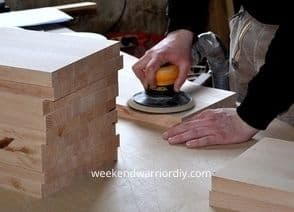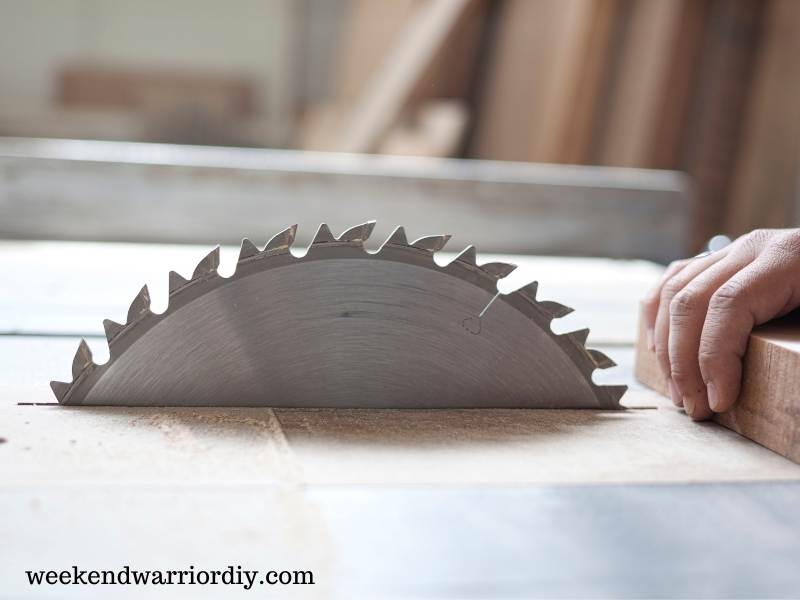Recently, I was using my bandsaw and was thinking about when I might need to change the blade. I have had the saw for a few years and have yet to change the blade. I don’t use it every week and only cut thin wood. I use softwoods no thicker than ¾” and ¼ to ⅜” plywoods only. I have noticed a of couple things with the saw lately that makes me want to change the blade right away. I thought this would be a great topic in case someone else out there is wondering if they should change their bandsaw blade.
Bandsaw blades should be changed if you need to press harder (feed pressure) on the wood to have it cut properly; the blade and saw start making a noise that hasn’t been heard previously; the wood starts burning; there’s visible damage such as hairline cracks; or it’s been a long time since a new blade was installed.
The last few weeks I’ve been noticing edges of plywood splitting easier than previously and it just feels like it’s taking more effort to push the wood through the blade now. That’s what sparked me to write this article. If I can help someone from having wood split unexpectedly or even have cut edges burn, then why not?
Let’s get right into it.
Signs You Need to Change Your Bandsaw Blade
From years of experience, I think these should be most of the reasons that’ll come up causing you to consider changing your bandsaw blade. Some aren’t serious and you could keep using the same blade if you really wanted to, however, some issues can cause damage and harm to the operator.
- You might not notice this issue for quite some time, especially if you don’t use your bandsaw daily but what often happens when blades start getting dull is it takes more pressure/force from the user. It doesn’t sound like a big deal but isn’t life all about making things easier on yourself? If it’s taking a bit more pressure to push the wood through the blade, then it’s probably time for a new sharp blade.
- If your bandsaw blade heats up more than it should – meaning you start to notice every time you use it that the blade is hot – either the blade is loose and needs to be tightened or more than likely the blade is getting dull. When a blade gets dull and the user is pushing wood against it to be cut, the blade does more rubbing instead of cutting which causes it to heat up.
- When a blade gets dull the chances of the wood being burned increases. I know a lot of people are into shou sugi ban, however if you’re using a bandsaw, you don’t want the wood to burn. Of course, the blade might need adjusting or possibly you’re putting force on the side of the blade causing this to happen. Once you determine you’re not doing those things, then chances are the blade is old which again means time for a new one.
- Here is one circumstance that drives me crazy. When you’re cutting thin plywood and the edges start chipping. This could be one or more of a few things. 1. You’re using the wrong blade. If you’re doing cuts that are practically finished ready, then opt for a blade with more teeth per inch. 2. You need much more practice cutting and over time you’ll improve, and the cuts will be cleaner. 3. The blade’s teeth are getting dull, or one has a chip or is broken. If any parts of a blade are missing, replace it immediately for your own safety.
- This one hasn’t happened to me yet, thank goodness. If you do a visual inspection of the blade and happen to notice a crack, it’s time to replace the blade immediately. DO NOT USE A BANDSAW BLADE IF YOU FIND A HAIRLINE CRACK. This can be extremely dangerous to your safety.

Another Great Reason to Change Your Bandsaw Blade
If by chance you are in the workshop everyday and your bandsaw is one of your go-to cutting tools, then maybe it’s time to change the blade.
Sometimes we need to change blades because of the desired results of the operator. There are a few different types of blades that all make a bit of difference when cutting.
- A regular bandsaw blade is most likely what you have installed on your bandsaw if you don’t just know. It’s the kind that comes with new bandsaws when purchased. These blades have straight-faced teeth which are evenly spread apart with deep gullets. They are great for an all-purpose kind of cut. Most woods and thin metals can be cut with these blades.
- A hook-tooth bandsaw blade has teeth that are spread wider apart than a regular saw blade. This means less teeth per linear inch. Hook-tooth blades have deep gullets. Because of the combination of deep gullets and teeth spread further apart, they can cut through materials much quicker than a regular blade. These blades are great for all around rough cuts, ripping and tearing through thick wood, plastics, and metal.
- Last up is the skip-tooth bandsaw blade. These blades differ from other bandsaw blades in that they have shallow gullets and a 90-degree tooth mixed in with the regular rake style teeth. The 90-degree teeth ensure wood chips come out of the cut clean and not get stuck causing you to stop the saw and pick out a sliver of wood. These are the ultimate non-clogging bandsaw blades.
Whether you need to change the blade for the type of cuts you desire or not, sometimes after a long period of time, it’s a good idea to replace the blade – even if you think the blade is in decent shape. You would be surprised at the difference a new sharp blade will make.
Here are some good Bandsaw blades available over on Amazon if you happen to be looking.
How to Fold a Bandsaw Blade
If you’re changing out bandsaw blades and don’t want to have a 5’ blade hanging on the wall, there’s a fairly easy and straightforward method for folding them. If you fold them, you can wrap some string or tape around the blade to keep it in place.
Here’s how to fold a bandsaw blade quickly and easily.
- Put on a pair or workshop gloves so the teeth of the blade don’t nick your skin.
- Take the blade in both hands palms up with teeth facing away from you.
- Allow the bottom of the blade to touch the floor. Using one footstep on the blade, securing it in place while holding the top of the blade in both hands.
- Taking both hands while in palms up position, twist hands inward so palms start to face your body.
- While twisting your hands inward, you’ll notice the blade start to collapse on itself.
- Follow the blade downward to the floor.
- Your blade should be folded.
- Pick up the blade and secure it with twine or tape.
It’s just that easy!

Conclusion
To conclude this article, I want to mention briefly again that sometimes we don’t even know a blade needs to be changed until we do it. The difference in the cuts can be night and day.
I know this from experience, especially with power tools that I don’t use as often as others. With these tools, it’s hard to know unless there is an obvious problem like burning wood or cracks in the blades.
Whatever you do, however, make sure to be smart and be safe. If you think it’s time for a blade change, do yourself a favor and spend the money.
Thanks for reading and good luck!
Related Posts
How to Cut Straight with a Bandsaw (Is it Even Possible)?



